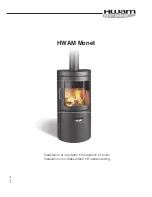
9
2.6.3
Positioning the outlet terminals
The outlet terminals for forced-draught appliances may
be located in the external perimeter walls of the building.
To provide some indications of possible solutions, Table
5 gives the minimum distances to be observed, with refe-
rence to the type of building shown in Fig. 10.
Notes
1) Terminals below a practicable balcony must be loca-
ted in such a way that the total path of the smoke from
its outlet point from the terminal to its outlet point from
the external perimeter of the balcony, including the
height of possible railings, is not less than 2000 mm.
2) When siting terminals, where materials that may be
subject to the action of the products of combustion
are present in the vicinity, e.g., eaves, gutters and
downspouts painted or made of plastic material,
projecting timberwork, etc., distances of not less than
1500 mm must be adopted, unless adequate shiel-
ding is provided to guard these materials.
2.6.4
Coaxial duct outlet on roof
To install this type of arrangement, the following are avai-
lable as optionals:
– roof outlet terminal ø 60/100, length 1280 (Code
8091200);
– articulated-joint roof tile (Code 8091300);
– extension ø 60/100, length 855 (Code 8084804);
– supplementary 90° elbow ø 60/100 (Code 8085601);
– vertical extension ø 60/100, length 200 (Code 8086903).
When assembling the accessories, remember that the
roof discharge terminal (length 1280 mm) cannot be
shortened and that the articulated joint of the roof tile
allows roof pitches of between 25 ° and 45°.
The tile is a plane roofing tile (1, Fig. 11) and comes fit-
ted with a shaped and folded lead panel (dimensions
160 x 440) for adaptation to the roof.
When joining the tile to the terminal, use the collar inser-
ted on the latter (3, Fig. 11), fastening it in position with
the three self-tapping screws provided.
When positioning the roof tile make sure to leave a distan-
ce of not less than 600 mm from the discharge top of the
roof-outlet terminal.
It is possible to insert up to a maximum of three
extensions and reach a maximum rectilinear distance
of 3.7 m. Should it be necessary to make two changes
of direction in the pipe development, the maximum
length of the pipe must not exceed 2 m.
Siting of terminal
Appliances from 7 to 35 kW
(min. distances in mm)
A - Below openable window
600
B - Below ventilation opening
600
C - Below eaves
300
D - Below balcony (1)
300
E - From adjacent window
400
F - From adjacent ventilation opening
600
G - From vertical or horizontal soil or drain pipes (2) 300
H - From corner of building
300
I - From recess in building
300
L - From ground level or other treadable surface 2500
M - Between two terminals set vertically
1500
N - Between two terminals set horizontally
1000
O - From a surface facing, without openings
or terminals
2000
P - As above, but with openings or terminals
3000
TABLE 5
KEY
1 Tile with articulated joint
2 Lead panel
3 Collar
4 Self-tapping screw
5 Reducing
Fig. 10
Fig. 11












































